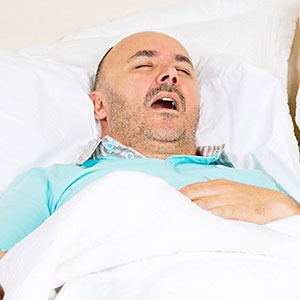 Sleep apnoea (or apnea) is a potentially serious condition that is caused by the narrowing of airways at the back of the mouth behind the tongue. Our bodies relax when we are sleeping. A large amount of the muscles will become floppy in this relaxed state, which is not necessarily a bad thing. However, when the muscles responsible for keeping the throat open collapse in such a way they will obstruct your airway, it may be problematic. At first, the narrowing of your airways may cause snoring but the noisy condition could also develop into sleep apnoea.
Sleep apnoea (or apnea) is a potentially serious condition that is caused by the narrowing of airways at the back of the mouth behind the tongue. Our bodies relax when we are sleeping. A large amount of the muscles will become floppy in this relaxed state, which is not necessarily a bad thing. However, when the muscles responsible for keeping the throat open collapse in such a way they will obstruct your airway, it may be problematic. At first, the narrowing of your airways may cause snoring but the noisy condition could also develop into sleep apnoea.
Clinically speaking, sleep apnoea occurs when the sufferer’s breathing is either completely or partially obstructed, resulting in reduced airflow for about 10 seconds or more. Although women and children also suffer from the condition, it is mostly found in overweight, middle-aged men.
Taking place throughout the night, the breathing interruptions occur approximately once every minute. The sleeping disorder significantly deprives the sufferer of adequate rest during sleeping hours resulting in a loss in energy levels during the day. Besides daytime lethargy, which is common amongst sleep apnoea patients, the condition can lead to more serious consequences if left untreated.
The most common type of the sleeping disorder is Obstructive Sleep Apnoea, which accounts for approximately 52% of sleep disorders in Australia1. The most telling sign that a person is suffering from obstructive sleep apnoea (OSA) is snoring in a loud and persistent fashion. OSA sufferers are also known to choke or gasp for air during sleep. Besides these nocturnal evidences, the resulting sleep deprivation would normally manifest in the following daytime symptoms: stress, headaches, irritability, depression, dry mouth, lack of concentration, memory loss and bad temper.
Studies have linked the condition to serious health complications, suggesting that OSA sufferers are more likely to suffer from stroke and heart disease2. Many OSA sufferers are not aware of their own condition – a small percentage has been diagnosed or received treatment. This disturbing notion is compounded by the fact that the breathing disorder increases the risk of sudden death. This can adversely impact the patient as well as other people, for example, if OSA sufferers are operating a vehicle when sudden death occurs.
Sleep apnoea can affect people of any age. Middle-aged males who drink, smoke or are obese belong to the high-risk group. Treatment ranges from lifestyle changes (weight loss), medical devices (CPAP machines) and dental appliances. Dentists usually recommend treatment in the form of a Mandibular Advancement Splint (MAS). The dental appliance is designed to reposition the lower jaw – and indirectly the tongue – such that it does not obstruct your airway.
The mouthpiece fits over and repositions the lower jaw, and indirectly the tongue, such that it does not obstruct your airway. Regular use of this clinically tested dental device can help to re-condition your breathing habit while giving you restful nights with easy breathing. Using clinically tested materials, the dental device can lead to a night of easy breathing.
To find out more about our dental solutions for your sleep apnoea problems, call Sydney CBD Dental at 02 9051 0503.
References:
1. "Re-awakening Australia." The Economic Cost of Sleep Disorders in Australia, 2010. October 1, 2011. Accessed December 16, 2015. http://www.sleephealthfoundation.org.au/pdfs/news/Reawakening Australia.pdf.
2. "Sleep Apnea and Heart Disease, Stroke." July 1, 2015. Accessed December 16, 2015. http://www.heart.org/HEARTORG/Conditions/More/MyHeartandStrokeNews/Sleep-Apnea-and-Heart-Disease-Stroke_UCM_441857_Article.jsp#.